K.M. Alexander's Blog, page 33
March 21, 2019
An ECCC 2019 Debriefing
This past weekend I joined thousands of others in attending the 17th annual Emerald City Comic Con in my hometown of Seattle, Washington. It’s incredible how far this show has come. This year I attended two days, Friday and Saturday alongside my friend and fellow writer Steve Toutonghi. (The paperback for his novel Side Life lands on April 9th, and you can and should preorder it now.)
I didn’t take a ton of photos this time. My iPhone is starting to show its age, and I am less inclined to snap photos as I wander. Besides, photographers more talented than I have it handled. If you want to see the cosplay, SYFY Wire did an excellent job covering the scene. They have galleries for Day 1, Day 2, Day 3, and Day 4. I recommend checking ‘em out.

March 19, 2019
Aubers: A Free 18th Century Cartography Brush Set for Fantasy Maps
I’ve always been fascinated by the early maps of North America; the history of the continent is clear in the signs and symbols. You can see the colonizers march slowly across a wild continent and read their fear of both the indigenous population and the unknown landscape. The colonized and the colonizer and the ramifications therein is a common story throughout history, and it’s a story that’s been told many times in fantasy literature. It’d make sense there would be a desire for maps that can help tell those stories.
With that in mind, I’d like to introduce my newest free brush set: Aubers. The set comes from Carte d’une partie de l’Amerique Septentrionale which shows the journey of François Pagès a French naval officer who accompanied the Spanish Governor of Texas on a lengthy exploration through Louisiana, Texas, and Mexico in 1767. The map was engraved by J.B.L. Aubers under the direction of Robert Bernard in 1782. It’s particularly interesting because it details the settlements of the indigenous peoples of Mexico and the American Southwest. You can also see the reach of Catholic missionaries during the late 18th-century. It’s a momentary glimpse of Nueva España frozen in time.
[image error]A small example of the brushes included in Aubers
Stylistically it’s unique. Aubers has an interesting way of rendering flora and his landforms have a style that sets his work apart from other engravers. Within this set, you can also observe a transition happening in cartography. Aubers blends the detailed pictographic style common in early 18th-century work with newer and cleaner icons that would dominate the 1800s. Instead of rendering small pictograms we see a transition to cleaner and simpler signs used for larger settlements (circle with the dot) and forts (simple squares.) It’s an interesting blend and a harbinger of something that would eventually standardize over the next century.
Inside Aubers you’ll find over four hundred brushes, including:
15 Major Cities
15 Large Towns
10 Small Towns
50 Habitations (These normally used to mark farms or tiny villages)
4 Archdioceses
2 Dioceses
20 Forts
10 Missions
25 Native Villages
3 Native Villages with Missionaries
4 Port Indicators
100 Scrub Trees
75 Scrub Land
50 Mountains
40 Mountain Ranges
3 Volcanos!
2 Map Cartouches
10 Numbers (0-9)
2 Odd Brushes that I couldn’t really categorize
The button below links to a ZIP file that contains a Photoshop brush set (works in GIMP as well) and a transparent PNG in case you’re using a program that doesn’t support ABR brush files. You can see the transparent PNG here. (They’ll come up black if viewed in Chrome, but they’re all there.)
As with all of my brush sets, Aubers is free for any use and is distributed with a Creative Commons Attribution 4.0 International License that means you can freely use it in commercial work and distribute adaptations. All I did was convert it to brushes, Aubers, Bernard and François Pagès did all the heavy lifting—so giving them credit would be fantastic, but it’s absolutely not necessary.

March 14, 2019
A Riverboat’s Passengers
In the middle of the nineteenth century, the fastest means of travel among the mid-western states was the steamboat. Trips that once took months—especially upriver—were reduced to weeks, and with this increase in speed, the shipment of freight formed a lively trade along the Mississippi and her tributaries.
It’s no wonder that passengers were attracted to steamboat travel. The broad decks were a luxury compared to cramped confines of stagecoaches or the hard life of the trail. To maximize profits riverboats maintained a wide variety of accommodations for all manner of traveler. These were largely separated into two categories, the hardscrabble experience of Deck Passage and the lavish Cabin Fare and the differences between the two were often striking.
Deck Passage
The lower deck—or main deck—was a loud, hot, dirty, and often a dangerous place. Boilers and engines rumbled at all hours. Freight was of prime importance and it was loaded before deck passengers—this included any animals. Fares could run as low as a quarter-center per mile which was appealing to the poor who chose to travel by packet, but while preferable to the road, this sort of passage was not easy.
“Whoever is not obliged to save a few dollars, should avoid this Trojan belly into which the poor are packed like herring, giving up all comfort.”
—Samuel Ludvigh, Light And Silhouettes Of Republican States
Those who paid the meager fare for deck passage were largely left to their own devices. While meals could be purchased on some boats often these passengers were responsible for their own food and sleeping arrangements. Much of the time a stove was provided to prepare their own meals and provide warmth—but during the height of travel season with upwards of two-hundred deck passengers onboard, it was often difficult to get a turn.
[image error] American Agriculturist — A Night On The River — “Missouri Roustabouts” (Detail) – Click to see the full version
Deck passengers were required to stay out of the way of the packet’s rousters and those that got in the way suffered abuse. Some captains allowed male deckers to reduce their fare aiding the crew in “wooding the boat” the act of loading cordwood fuel from woodyards erected alongside the river. If money was tight and one could handle the hard labor this could cut the already reduced fare in half.
Beds were where you found them. There was little space provided for sanitation, often just a bucket to draw river water. Weather could be harsh, and sickness was prevalent; cholera and yellow fever weren’t uncommon. Should the boat meet a disaster, often it was the deckers who suffered the most.
Cabin Fare
For those who could afford it, cabin fare was an extravagance compared to the hardships suffered below. Most boats offered comfortable accommodations while other packets were outfitted as luxurious floating hotels complete with service staff.
Cabin fare tickets provided the passenger with board, a comfortable bed, as well as transportation on the packet’s boiler deck—named so because it sat above the vessel’s boilers. Here, elegant staterooms flanked a central saloon that served as a dining hall and lounge. Toward the stern of the boat was a space reserved for ladies and families with children, while the menfolk tended to congregate near the vessel’s barroom—usually located forward.
“I could not help lolling carelessly upon the railings of the boiler deck to enjoy the envy of the country boys on the bank.”
—Mark Twain, Life on the Mississippi, Chapter 5
When not feasting, drinking, gambling, or conversing cabin passengers could spend time strolling around the riverboat’s covered promenade that encircled the second deck. Here they watched the scenery drift past and enjoyed the fresh air. Like on the oceangoing steamers deck chairs were provided and the passengers could laze about, reading, chatting, or napping while they waited for their next meal.
[image error] Up the Hudson—Drawn by A. E. Emslie (Detail) – Click to see full version
Above the boiler deck was the hurricane deck—named for the constant wind that blew across its open expanse. Most captain’s allowed passengers to ascend and take in the expansive views of the river below and enjoy and enjoy the breeze. It wasn’t uncommon for travelers to pose for photos near the boat’s pilothouse as a souvenir of their travels.
Usually, this sort of journey was only made available to the white passenger, African Americans, Native Americans, and non-white immigrants were generally limited to deck passage. Later in the century, there were instances of first-class accommodations for black passengers. But these were built as an extension of the Texas deck, the uppermost deck constructed atop the hurricane deck, usually restricted to captain and crew. An early predecessor of racist “separate but equal” Jim Crow laws that would plague the South until nearly a century later.
I’ve always been attracted to travel by boat, train, or airship. There’s something about the wide open space and private quarters that makes that type of travel more appealing. The traveler onboard a packet is free to wander and reflect on the passing countryside. The riverboat becomes a small world of its own for a time and its passengers a community—even temporarily. Add in the lives of the crew, the deck passengers, and the wealthy cabin passengers and you have a setting that is ripe for drama. That served as a major driving force for me to write Coal Belly. I liked the idea of a working vessel that was as much someone’s home as it was a means of transportation.
Below are some photos of riverboat passengers I’ve gathered during the years of my research for Coal Belly. You can click on any photo to view it larger. I’ve laid them out in the order of a trip, from passenger’s boarding, snapshots taken while underway, to the passenger’s final departure.




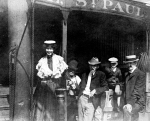
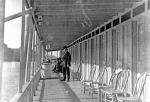




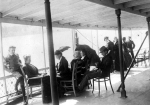


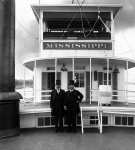
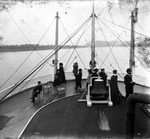


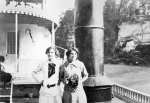
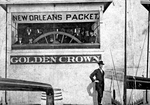
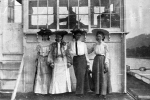

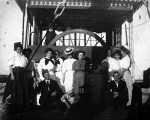


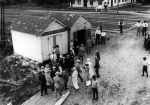
All the images above were collected over the last six years, so I am unsure where they all come from (usually the Library of Congress or from research at my local libraries.) But, they’re all old enough they should all be in the public domain. If something looks or seems amiss, please let me know and I’ll correct it.
In some cases, I did some minor color correction and cropping to keep it all visually consistent. I’m happy to answer any questions folks have about any of these images or riverboats in general. (Sometimes it gives me a good excuse to research something.) You can send me an email or leave a comment below.
A Riverboat’s Passengers is the latest in my series of posts sharing my research for my future novel Coal Belly. You can check out the other riverboat-related posts with the links below.
A Riverboat’s Demise
A Riverboat’s Pilothouse
Riverboats at War
A Riverboat’s Roustabouts
A Riverboat’s Menu
Riverboat Interiors
Riverboats & Levees
The Masonic Ironclad
 Want to stay in touch with me? Sign up for Dead Drop, my rare and elusive newsletter. Subscribers get news, previews, and notices on my books before anyone else delivered directly to their inbox. I work hard to make sure it’s not spammy and full of interesting and relevant information. SIGN UP TODAY →
Want to stay in touch with me? Sign up for Dead Drop, my rare and elusive newsletter. Subscribers get news, previews, and notices on my books before anyone else delivered directly to their inbox. I work hard to make sure it’s not spammy and full of interesting and relevant information. SIGN UP TODAY →
March 13, 2019
ECCC, St. Patrick’s Day, Public Transportation, and You
Emerald City Comic Con is this weekend in Seattle, and I will be in attendance alongside upwards of 90k other people. It should be a good time. (If you see me, say hello. I’m the big guy in all black—no not that one, or that one, or that one, no… I’m the other one.)
It is also Saint Patrick’s Day on Sunday which means there will be two other events bringing even more people downtown. That can make the city core a little chaotic at times. Since I live and work in Seattle, I figured I’d offer up some advice for those coming in from out of town. (This was born from a twitter thread, but having this all in one place will be handy.)
The con begins tomorrow and runs through Sunday at the Washington State Convention Center and surrounds just a few blocks up Pike St. from Westlake Park. Thursday and Friday should be fine (though the Friday night commute might be a little hairy.) Saturday and Sunday will be busy. Along with the typical beer-drinking St. Patrick’s Day revelers two themed-events are happening over the weekend.
Saturday:
The Irish Heritage Club’s Saint Patrick’s Day Parade is on Saturday at 12:30. It starts at James St. and 4th Ave. and heads north where it ends at Westlake Park. Here’s the route.
Sunday:
The 35th Annual Saint Patrick’s Day Dash is on Sunday and runs from 6:30-12:00. It starts at Seattle Central runs down 4th Ave, turns around and spring and comes back. Here’s the route.
That combo is going to draw a lot of people in green downtown. If you’re driving in, expect a bit more traffic than usual, and know that parking will be harder to find. Your best bet is a garage which can be expensive, but they’re convenient as long as they’re not full. Two main garages service the WSCC, and you can find pricing here. You can expect similar prices at other garages nearby. Those will fill up fast.
There is, of course, another option…
Transit:
Your best bet in my opinion, if you’re driving into the city from out of town, is to take the Sound Transit Link Light Rail—parking will be cheaper near stations outside of downtown, and it’s a single line. so it’s impossible to get lost. Convenient and cheap!
There is a stop directly under Westlake Park called Westlake Station and an exit for 5th and Pine (follow the signs) it’ll lead you past Nordstroms and deposit you on the other side of both the revelers and race. From there its only a few blocks to the convention center.
Plus with a Day Pass (about $5), you can skip the long lines for food around the con and ride up to Capitol Hill or down to the Chinatown-International District where you’ll find much better food than anything downtown and quieter crowds.
Hopefully, a few people will find this advice helpful. Whatever you do, I always recommend giving yourself more time when events overlap. Personally, I plan on taking the light rail every day—it should make things nice and smooth.
Have a question? Leave a comment below or shoot me an email, I’ll do my best to answer any questions.
I’m looking forward to hanging out this weekend. Hopefully, I’ll see you at ECCC.
March 10, 2019
The Whole Thing About Perfectionism
“You know, the whole thing about perfectionism. The perfectionism is very dangerous. Because of course if your fidelity to perfectionism is too high, you never do anything. Because doing anything results in…it’s actually kind of tragic because you sacrifice how gorgeous and perfect it is in your head for what it really is. And there were a couple of years where I really struggled with that.”
March 7, 2019
Spam & Comments
In the last week, I’ve seen a significant uptick in spam comments here on my blog. Comments aren’t something I get a lot of on this blog and, generally speaking, WordPress’ Akismet service does an excellent job of filtering the noise. But with thousands of spam comments coming in I started seeing several an hour slip through my fortifications. Since I manually approve every comment, spam has moved from annoyance to problem.
At this point, the easiest solution is to turn off comments for older posts. (Spambots are really keen on old posts for some reason.) Most real people don’t comment on older content—so I don’t think it hurts anything killing comments there. Going forward if something strikes your fancy around here, you’ll have seven days to comment. After that comments will be closed.
Have something you want to say to me on older content, new content, or just anything in general. Shoot me an email.
March 5, 2019
Choose Your Fighter: An Oxford Comma or a Five Million Dollar Legal Loss
In this house, we respect and hold to the Oxford comma. We believe its existence is essential for clear communication and AP Style is inferior because of its omission.
But what if I told you that we’ve gone beyond opinion? What if here in the States a missing Oxford comma now holds legal implications, and its exclusion can cost a lot? Well, we Oxford comma disciples have recently won a great victory. Thanks to a 2017 ruling from The State of Maine we now have a legal precedent for the inclusion of our beloved Oxford comma as this handy video from Half as Interesting explains.
Huzzah! Long live the Oxford Comma! Long live our Punctuation Champion of the World!
 Want to stay in touch with me? Sign up for Dead Drop, my rare and elusive newsletter. Subscribers get news, previews, and notices on my books before anyone else delivered directly to their inbox. I work hard to make sure it’s not spammy and full of interesting and relevant information. SIGN UP TODAY →
Want to stay in touch with me? Sign up for Dead Drop, my rare and elusive newsletter. Subscribers get news, previews, and notices on my books before anyone else delivered directly to their inbox. I work hard to make sure it’s not spammy and full of interesting and relevant information. SIGN UP TODAY →
March 3, 2019
Garden of Horrors: Gymnosporangium Juniperi-Virginianae
The natural world is often stranger than we give it credit, case in point heteroecious rust fungi which requires two hosts to complete their lifecycle. And some choose to do it in the creepiest way possible.
Enter Gymnosporangium juniperi-virginianae more commonly known as cedar-apple rust. The only thing more disturbing than its letter-salad binomial name is the way it looks—in particular in the spring when the pathogen is ready to leave its cedar/juniper home and find its next host.
[image error]The gall of Gymnosporangium juniperi-virginianae with telial horns
See what I mean? There’s something downright disgusting in those creepy finger-like protrusions. They remind me of an inverted tree-anemone (a comparison that is even more accurate when they’re wet.) Those are called telial horns, and they sprout from galls created by the fungus from the year before. Once it warms up the galls “sprout” and begins spreading spores that are usually looking for apple trees, although it’ll happily infest pears or hawthorns as well.
It’s not kind to the fruit trees either. Infestations can reduce the yield on crops and cause blemishes in the fruit—they can also kill the cedar trees as well. It’s so widespread that there’s loads of information out there focused on prevention. Luckily, the Teliospores can’t travel too far. So the best way to control the fungus is to remove cedars found within a mile of orchards. No cedars no fungus.
Here’s a quick video from Cornell University showing a timelapse of the horns growing from the fungi galls over six days. Vermiphobes you might want to look away.
Happy gardening.
 More Garden of Horrors
More Garden of HorrorsHydnora Africana
Pterocarpus Angolensis – aka – Bloodwood Tree
Hydnellum Peckii – aka – Bleeding Tooth Fungus
Clathrus Archeri – aka – Devil’s Fingers
 Want to stay in touch with me? Sign up for Dead Drop, my rare and elusive newsletter. Subscribers get news, previews, and notices on my books before anyone else delivered directly to their inbox. I work hard to make sure it’s not spammy and full of interesting and relevant information. SIGN UP TODAY →
Want to stay in touch with me? Sign up for Dead Drop, my rare and elusive newsletter. Subscribers get news, previews, and notices on my books before anyone else delivered directly to their inbox. I work hard to make sure it’s not spammy and full of interesting and relevant information. SIGN UP TODAY →
February 27, 2019
#NoBadMaps
I am a firm believer that creators should help other creators. I don’t look kindly on folks who refuse to share process, advice, and experience. The world is already a savage, selfish, and cutthroat cesspool, and dragging that attitude into the creative sphere is counterproductive. It doesn’t matter if it’s writing strategy, musical tips, painting advice, or one’s approach to performance; we should—as a rule—lift each other up. Make the world a better place.
Enter: #NoBadMaps. My next venture into doing just that.
For much of my life, I’ve been a designer. I’ve worked for companies large and small and I love it. It’s offered unique challenges, it’s changed the way I’ve viewed the world, and it’s made me reevaluate how I see others. (Plus, it made it a lot easier to release my own books.) But not everyone is a designer. That’s okay. We have strengths and weaknesses and we should use our strengths to help others.
[image error]
Recently, many of you have noted my release of Photoshop brush sets designed for the creation of fantasy maps. There is a reason for this and it harkens back to focus on helping others. Within the realm of genre fiction many readers, myself included, are keen on maps. They can help us see a world more fully and they go a long way to enliven the text with a sense of place. Are they necessary? Not always, but much of my own reading has been enhanced with the inclusion of a map. I want to pass that experience onto others as well.
We’re nearly two decades into the 21st Century and we’ve seen the rise of indie publishing and along side that enormous growth in genre fiction. It’s no surprise that many authors—traditional and indie—want to make their own maps. But, it can be a struggle. Fantasy cartography is a skill set that takes time to hone, most writers want to write and don’t want to put in the effort to learn map-making. This is why I started #NoBadMaps—my goal is to make it easy for authors to create high-quality maps for their novels and do it in a way that doesn’t cost them an arm and a leg. While there is no substitute for professional illustration, I want to do my damnedest to help writers get as close to professional as they can.
[image error]
Using my brushes is easy: you load them in Photoshop, create a document, and place what you want where you want it with a few mouse clicks. Point-and-click. There’s very little drawing, no scanning, nothing complicated. In fact using any of my brush sets you can make super cool maps in minutes. That’s intentional. The end result is to empower authors to create better maps that fit the style of their books.
Of course, I have rules.
The brush sets will always be free. This is key, after all the goal is to help others. If I charge for this stuff it feels predatory. All of the work I am using is in the public domain, all I am doing is making the style more accessible. No sense charging for what is already free, ya dig?
The brush sets will always be royalty-free. I want to see people use my brushes for both personal and commercial projects. The maps are already public domain, no reason why the brush sets shouldn’t be as well.
The brush sets will always be varied. One of the things I want is to help recreate that feeling of hand-drawn maps. That means I will do my best to capture and share the imperfections found in ink-on-paper maps. If you want machine-made creations, look elsewhere. We’re going for authenticity with #NoBadMaps.
The brush sets will connect to history. I think this is vital. It’s why I name the sets after the engravers when possible and like to include a brief history on the map and the maker. I think it’s important to recognize the creators and in a way, this helps their creations live on.
With Monday’s release of L’Isle, I’ve now shared five sets in total and I have several more on the way. I’ve gotten enough questions that I felt this post was necessary to address concerns from my readers. Let me make this clear: my focus is still on writing, it will always be on writing, but I want to share my experience and empower others to create great maps. My brushes are a way of helping other authors create something beautiful.
A few people have asked how they can support this work. My first rule is very clear: these brush sets will always be free. I’m not planning on starting a GoFundMe, nor do I want to manage a Kickstarter, and—if I’m being honest—I cringe a little at Patreon. (A subject for another post, providing Patreon lasts that long.) If you want to support me and my work: buy what I create. In my case, it’s my books. Buy ‘em. Read ‘em. Tell people about ‘em. Leave honest reviews. Give them to friends. They’re good. They get positive reviews. They’re wonderfully weird.
That’s it. That’s how you can support me. It’s simple.
Going forward I plan on doing a few things:
Keep writing. I recently put up some big numbers in Gleam Upon the Waves and I have updated the tracker in the side bar. No ETA on launch, but I’m moving along.
Release more brush sets. I have at least three that I’m finalizing. So expect more to come. I’m really focused on finding variety. There are thousands of old maps, and making sure each set remains unique is key.
Write some more.
Tutorials! I want to share tips, tricks, and ways to best optimize the brush sets for your projects. This might include expanding beyond the typical map elements of landforms, flora, and settlements.
Write. Write. Write.
#NoBadMaps will continue for the foreseeable future. If you have questions feel free to leave a comment or shoot me an email. There’s a lot more stuff to come, and I am excited to share it with everyone.
 Want to stay in touch with me? Sign up for Dead Drop, my rare and elusive newsletter. Subscribers get news, previews, and notices on my books before anyone else delivered directly to their inbox. I work hard to make sure it’s not spammy and full of interesting and relevant information. SIGN UP TODAY →
Want to stay in touch with me? Sign up for Dead Drop, my rare and elusive newsletter. Subscribers get news, previews, and notices on my books before anyone else delivered directly to their inbox. I work hard to make sure it’s not spammy and full of interesting and relevant information. SIGN UP TODAY →
February 25, 2019
L’Isle: A Free 18th Century Battlefield Brush Set for Fantasy Maps
For a while, I’ve been releasing brush sets with the goal of aiding fantasy authors (and GMs, or anyone really) to create vibrant maps that really showcase their imaginary worlds. Personally, I love maps, a good map can draw me into a story and enhance the world.
Today’s brush set is a little different from previous offerings. Instead of focusing on landscapes, today’s set focuses on the battlefield. Violence, battle, and war is a common theme in fantasy and I figured this set would be perfect for those who are wanting something a bit different.
I’m calling this set L’Isle. The symbols are taken from the Plan Batalii map which was included in a special edition of The First Atlas of Russia in 1745. The map details the plan of battle near Stavuchanakh in Moldova, between the Imperial Russian Grand Army and the Turkish and Tartar Armies. The set is named after Joseph Nicolas de L’Isle who supervised the production. Usually, I name sets after the artist/engraver but this time around it was difficult for me to pin down the specific creator.[1]
[image error]A tiny fraction of the brushes included in L’Isle
With the help of my friend Redd, we translated the antiquated German from the original document. It tells a blow-by-blow of a battle during the Russo-Turkish War of 1735–1739. There’s a bit of a bias here—the Turks and Tartars are depicted as an unorganized horde while the Russian forces are shown using more standard and organized military symbols. But the symbols in themselves can work for anything: masses of soldiers, invading orcs, barbarians, an elvish army, fish men, whatever. If you’re looking to render elevation, I highly recommend pairing these symbols with Lehmann, my hachure brush set (you’ll need Adobe Illustrator.)
Inside L’Isle you’ll find, over 500 brushes, including:
51 Organized Unit Markers
75 Individual Horde Soldiers
85 Horde Armies
2 Tiny Tent Rows
40 Small Tents
13 Medium Tents
9 Large Tents
2 Extra Large Tents
5 Churches (Technically there was only one, but I did some Photoshop magic.)
20 Villages
25 Individual Homes
50 Individual Trees
25 Forests
30 Flags
3 Bunkers
13 Gun Batteries
47 Canons (Firing and Silent!)
13 Action Symbols (Explosions! Sword fights!)
4 Random Objects
The button below links to a ZIP file that contains a Photoshop brush set and two transparent PNGs in case you’re using a program that doesn’t support Adobe brush files. You can see the two transparent PNGs at the following links: Units and Elements (they’ll come up black if viewed in Chrome, but they’re all there.)
As with all of my brush sets, L’isle is free for any use and is distributed with a Creative Commons Attribution 4.0 International License that means you can freely use it in commercial work and distribute adaptations. All I did was convert it to brushes, L’isle and his engravers did all the heavy lifting—so giving them credit would be fantastic, but it’s absolutely not necessary.
If you like the L’isle brush set (or any of my free brushes, really) and would like to support my work, instead of a donation, consider buying one of my urban fantasy novels for yourself or a friend. (The first books is only $2.99 on eBook.) You can find them in stores and online, learn more about the series at bellforgingcycle.com. When my 2nd book in the series launched I made a map for the world, you can check it out here.




